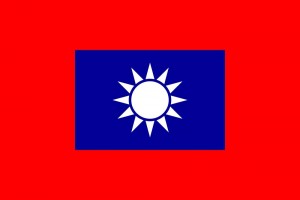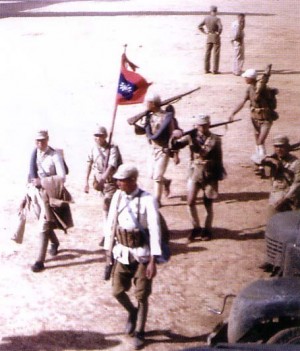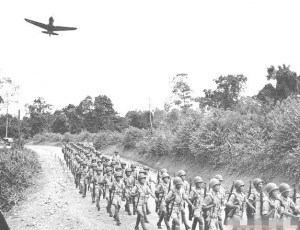 The National Revolutionary Army, also known as the National Army, was a military unit meant to unite China under a solitary line of power, disposing of the warlord regime of the past. Consisting of soldiers drawn from different regions of China, the army commanded immense respect from all corners of the republic. Since its inauguration in 1928, the army remained at the front lines, defending the People’s Republic of China from external attacks. It also took part in regional wars to foster peace among its neighbors in Asia.
The National Revolutionary Army, also known as the National Army, was a military unit meant to unite China under a solitary line of power, disposing of the warlord regime of the past. Consisting of soldiers drawn from different regions of China, the army commanded immense respect from all corners of the republic. Since its inauguration in 1928, the army remained at the front lines, defending the People’s Republic of China from external attacks. It also took part in regional wars to foster peace among its neighbors in Asia.
Furthermore, the army played a vital role in World War II when the government of China decided to stand by the Allies, including the U.S., U.K., France, and the USSR against Japan, Germany, and Italy. It was made up of three major units: the national army, the air force, and the navy.
The NRA played a central role in the Chinese civil war by conquering the People’s Liberation Army. It also battled against Japan in the Second Sino-Japanese war. It was a notable force to reckon with and as such was an important player in the Northern Expedition against the Beiyang Army Warlords.
With the establishment of the Constitution of the People’s Republic of China in 1947, the NRA was renamed the Republic of China Armed Forces with the majority of its men taking top positions in the newly formed military departments before retreating to Taiwan two years later.
Formation
The NRA was formed by the Kuonmintang in early 1925 as the military wing to protect the people of China from any form of attack and to unify them into one cohesive nation. The military force which operated on the 3 principles of the people was guided by Comintern. Most of its men were trained at the Whampoa Military Training Academy and its first commandant was Chiang Kai-shek. Other prominent people who played an instrumental role in the running of the affairs of the new army included Cheng Cheng and Du Yuming.
The army successfully accomplished its task of uniting China three years after its formation in 1928, though small scale warlord activities ensued for several years afterwards.
Working with the Germans
 One of the most crucial stages in the development of the NRA was when Adolf Hitler ascended to power to become the Nazi German Chancellor in 1933. The ruling Chinese party was soon engaged in close relations as Germany took up the role of training NRA troops and equipping them with a revised infrastructure. In exchange, China opened its markets and mineral resources to Germany.
One of the most crucial stages in the development of the NRA was when Adolf Hitler ascended to power to become the Nazi German Chancellor in 1933. The ruling Chinese party was soon engaged in close relations as Germany took up the role of training NRA troops and equipping them with a revised infrastructure. In exchange, China opened its markets and mineral resources to Germany.
One year later, General Hans Von Seeckt proposed an eighty division plan that was aimed at reforming the entire army unit into eighty sections of well-equipped soldiers with specialized training from Germany. However, this proposal never materialized as the different warlords fighting for power simply could not come to an agreement on who would take over the eighty units and who would give up a share of his battalion.
Three years later, only eight infantry bases had adhered to Hans’ recommendations. These included the training division, third, sixth, ninth, fourteenth, thirty sixth, eighty seventh, and the eighty-eighth divisions.
When the Second World War started, the military wing sent its soldiers to assist the Allied forces in China and India. This was closely followed by the introduction of a new constitutional order in China which saw the army renamed the RCAF.
Tactical Structure
The topmost position of the NRA was held by Chiang Kai-Shek. He was mandated to issue commands and to oversee responsibility among the staffs. Another top person in the military was General He Yingqin who served as the Commander in Chief from 1937. Other top-notch army leaders included those drawn from the naval and the air forces, garrison commanders, air defence commanders, military region heads, members of staff drawn from the War Ministry, and members of staff in charge of support services.
Throughout its existence, the National Revolutionary Army recruited about 4.3 million regular soldiers in 46 New Divisions, 370 Standard Divisions, 12 Calvary Divisions, 8 Calvary Divisions, 66 Temporary Divisions, and 13 reserve divisions adding up to a total of 515 divisions. On average, each division had close to about six thousand troops. Such was the immense manpower of the NRA that the U.S. army’s campaign brochure ranked it as one of the most superior forces on the world.
NRA Arsenals
 Most NRA weapons were produced in the Hanyang, Taiyuan and Guandong Arsenals. Regular provincial divisions used standard rifles known as the Hanyang 88 while central divisions were equipped with the Chiang Kai-Shek rifle. Other standard firearms were mostly imported from Germany.
Most NRA weapons were produced in the Hanyang, Taiyuan and Guandong Arsenals. Regular provincial divisions used standard rifles known as the Hanyang 88 while central divisions were equipped with the Chiang Kai-Shek rifle. Other standard firearms were mostly imported from Germany.
High placed troops used the standard light machine gun which was a replica of the 7.92 mm BRNO zb26 made in Czechoslovakia. There were also French and Belgian machine guns which were a preserve of the central divisions.
Heavy machine guns were manufactured within China including Type-24 Maxim guns, copies of the German made M1917s, and MGO8 machine guns.
The topmost units of the NRA used Lend-Lease military equipment from President Roosevelt’s government as WWII progressed.
Sections of the NRA were equipped with swords and spears in addition to a large supply of rifles which were utilized by the Muslim Ma-Clique divisions of the NRA.
Close Relations
The NRA worked closely with forces from Belgium, Canada, Czechoslovakia, Denmark, France, Germany, Italy, the USSR, Sweden, the U.K., and the U.S.
The NRA was an important player in the building of China and acted as a unifying figure fighting against troops which advocated for communism.